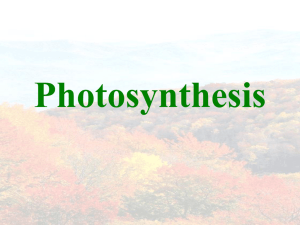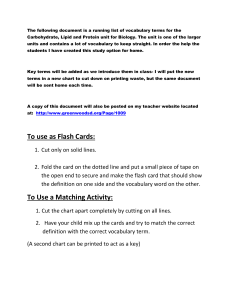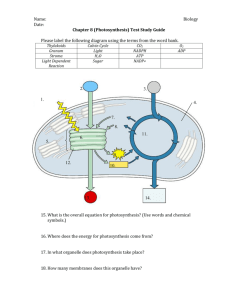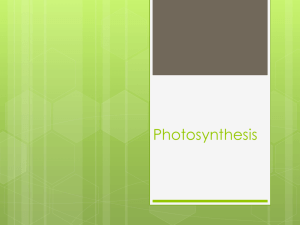Photosynthesis
advertisement
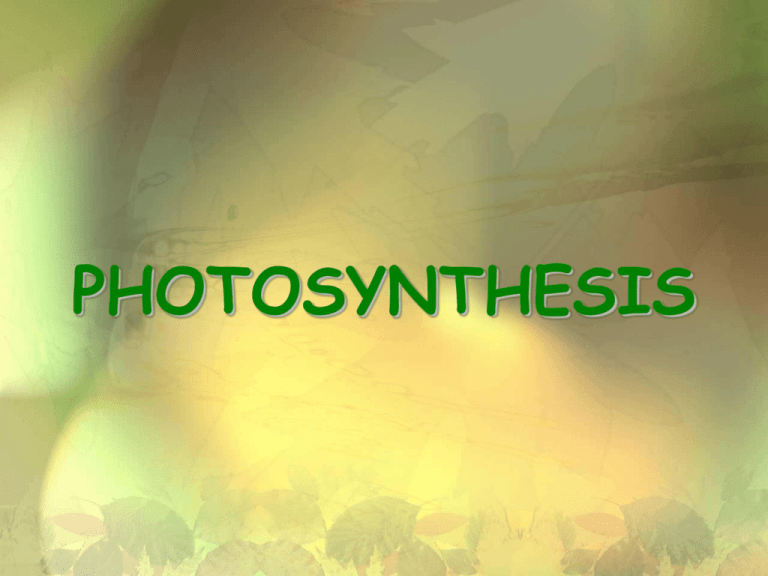
PHOTOSYNTHESIS Photosynthesis • Process that requires carbon dioxide (CO2), light energy (photons), and water (H2O) to produce organic macromolecules (glucose). SUN photons 6CO2 + 6H2O C6H12O6 + 6O2 glucose 2 Question: Where does photosynthesis take place? 3 Plants • Autotrophs – produce their own food (glucose) • Process called photosynthesis • Mainly occurs in the leaves: a. stoma - pores b.mesophyll cells Mesophyll Cell Chloroplast Stoma 5 Stomata (stoma) Pores in a plant’s cuticle through which water vapor and gases (CO2 & O2) are exchanged between the plant and the atmosphere. Stoma Carbon Dioxide (CO2) Guard Cell Oxygen (O2) Guard Cell Found on the underside of leaves 6 Mesophyll Cell of Leaf Nucleus Cell Wall Chloroplast Central Vacuole Photosynthesis occurs in these cells! 7 Chloroplast Organelle where photosynthesis takes place. Stroma Outer Membrane Inner Membrane Thylakoid Granum Thylakoid stacks are connected together 8 Thylakoid Thylakoid Membrane Granum Thylakoid Space Grana make up the inner membrane 9 Question: Why are plants green? 10 Chlorophyll Molecules • Located in the thylakoid membranes • Plants are green because the green wavelength is reflected, not absorbed. 11 Question: During the fall, what causes the leaves to change colors? 12 Fall Colors • In addition to the chlorophyll pigments, there are other pigments present • During the fall, the green chlorophyll pigments are greatly reduced revealing the other pigments • Carotenoids are pigments that are either red, orange, or yellow 13 Question: What do cells use for energy? 14 Energy for Life on Earth • Sunlight is the ULTIMATE energy for all life on Earth • Plants store energy in the chemical bonds of sugars • Chemical energy is released as ATP during cellular respiration 15 High Energy Phosphate Bond 16 Parts of Photosynthesis 17 Two Parts of Photosynthesis Two reactions make up photosynthesis: 1.Light ReactionsProduces energy from solar power (photons) in the form of ATP and NADPH. SUN 18 Two Parts of Photosynthesis 2. Calvin Cycle • Uses energy (ATP and NADPH) from light reaction to make sugar (glucose). 19 Stage 1: Light Reactions • Where do they occur? Thylakoid membranes • What is the starting molecule? Water • What are the end products? Oxygen, ATP, NADPH • This stage requires light! 20 Calvin Cycle FYI • Occurs in the stroma • Uses ATP and NADPH from light reaction as energy • Uses CO2 • To produce glucose: it takes 6 turns and uses 18 ATP and 12 NADPH. 21 Stage 2: Calvin Cycles • Where do they occur? Stroma • What is the starting molecule? Carbon dioxide (CO2), ATP, and NADPH • What are the end products? Glucose • This stage does not require light! 22 Chloroplast Outer Membrane Inner Membrane STROMA– where Calvin Cycle occurs Thylakoid Granum 23 The overall equation for Photosynthesis • 6CO2 + 6H2O + light energy C6H12O6 + 6O2 • In words: • Carbon dioxide + water + light energy Glucose + oxygen 24 Photosynthesis

